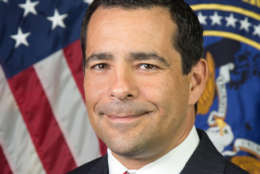Hubbard Radio Washington DC, LLC. All rights reserved. This website is not intended for users located within the European Economic Area.
On Air: Federal News Network
insider threat
-
As part of the Trusted Workforce 2.0 initiative, intelligence and industry communities are preparing to deliver their plan to reimagine the security clearance to Congress by the end of the year.
August 07, 2018 -
David Wajsgras, president of Raytheon’s Intelligence, Information and Services business, said the acceptance of dev/ops is causing vendors to rethink how they meet agency demands.
July 20, 2018 -
Roger Stanton, the assistant director of the insider threat office for the FBI, said the two technology platforms will help create a better culture of collaboration.
May 14, 2018 -
In part 2 of his commentary, Tom McMurtrie, a research fellow with the Army’s Training with Industry Program, details the challenges with implementing new approaches.
December 28, 2017 -
In part 1 of his commentary, Tom McMurtrie, a research fellow with the Army’s Training with Industry Program, offers details on the current state of agency efforts to protect against insider threats.
December 27, 2017 -
The National Counterintelligence and Security Center plans to deploy its own fully functional continuous evaluation system by fall 2018. Executive branch agencies buy into those services, and NCSC will continually vet agency employees against 10 different databases.
November 17, 2017 -
Daniel Payne, the director of the Defense Security Services, said the continuous evaluation program will have 1 million employees by 2018.
September 21, 2017 -
Whether you're a federal agency or a contractor, cybersecurity has become too important to leave solely to the tech staff. The worst threat these days seems to be the insider threat. Addie Cliffe and Evan Wolff, attorneys with the privacy and cyberscurity group at Crowell Moring, joined Federal Drive with Tom Temin to offer advice on how to take a corporate approach.
July 28, 2017 -
Near-weekly, worldwide cybersecurity threats underscore the importance of network, end-point, and application monitoring. Federal agencies have worked under a policy of continuous monitoring/continuous diagnostics and mitigation for a decade. But given the seemingly unending growth in attack vectors, the spread of internal infrastructure to commercial cloud providers, and the rise of insider threats – they’ve got to up the game into what might be called advanced cyber monitoring.
July 05, 2017 -
Insider Threat programs across all agencies must develop alongside technology, the GAO reports. However, the Department of Defense is making significant progress.
June 28, 2017 -
The Defense Information Systems Agency is hard at work on the next generation of mobile, secure computing for the Defense Department. And it's up to some heavy contracting activity.
June 27, 2017 -
Even if your people don't handle classified information, you can learn a lot from the National Insider Threat Task Force.
June 21, 2017 -
From proving bomb parts can get through front-door screenings to examining the Fort Hood shootings, the Government Accountability Office has been following the federal insider threat situation for years. Its work covers both the physical world and cyberspace.Joseph Kirschbaum, GAO director of defense capabilities and management, joined Federal Drive with Tom Temin to discuss the range of work he's overseen.
June 21, 2017 -
Wayne Belk, co-director of the National Insider Threat Task Force, wants feds to know that insider threat programs are there to protect them, not to get them in trouble.
June 19, 2017
















